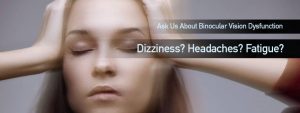Up to 20% of the population suffer from Binocular Visual Dysfunction (BVD).
If you experience headaches, blurred vision, anxiety, balance problems, and dizziness making simple everyday tasks difficult, you may have a common visual problem, known as Binocular Vision Dysfunction (BVD).
Binocular Vision Dysfunction (BVD), a condition where the eyes have trouble working together as a team to create one clear image.
BVD can have a major impact on your quality of life, impacting reading, computer use and performing to your best at school or the office.
What is BVD?
Binocular Vision Dysfunction occurs when the eyes are misaligned causing each eye to send a different image to the brain.
For people with normal binocular vision, their eyes work in tandem and are perfectly in sync at all times, which means the eyes send one clear and focused picture to the brain.
People with BVD have difficulty seeing one clear image at all times.
In most cases, the misalignment is very subtle, making it all the more difficult to identify. Even though the misalignment is small and physically unnoticeable, the symptoms can be debilitating.
BVD can result in double vision, fatigue, tiredness and loss of concentration, often leading to increased levels of anxiety and stress.
BVD can affects both adults and children lead to frustration and anxiety due to not being able to perform at your optimum at school or in the office.
BVD can manifest at any time, often without a definite cause, with symptoms usually experienced during school, college or after long hours at the office.
If you experience any of the symptoms listed above, find an eye doctor near you that may be able to help diagnose and treat BVD.
SEE RELATED: 2021 Update: BVD and Headaches
Causes of BVD
There are several different factors that can cause BVD;
Facial Asymmetry – Where one eye is physically higher than the other.
Nerve or Eye Muscle Dysfunction – Many people are born with reduced functioning of their eye muscles or ocular nerves. The eye muscles become more strained, from trying to constantly realign the images being sent to the brain. This constant effort results in fatigue and makes the BVD symptoms even worse over time.
Traumatic Brain Injury – TBIs, stroke, concussion, brain injury, or similar neurological disorder can cause damage to functioning of the visual system resulting in a misalignment of the eyes.
Symptoms of BVD
BVD symptoms can lead to a variety of symptoms, these can include;
- Dizziness
- Motion sickness
- Headache
- Light sensitivity and
- Anxiety
When to call the eye doctor?
If you find that you regularly suffer from any of the symptoms listed above it is highly recommended that you schedule an exam with an eye doctor that is trained and experienced in diagnosing and treating BVD.
Since many people are unaware of BVD, they do not know to ask their eye doctor to look out for it.
In addition, many people suffering from BVD have a small amount of vision misalignment that is not found on a routine eye exam. That is why it is so important to visit an eye doctor that has experience in BVD.
LEARN MORE: Guide to Binocular Visual Dysfunction (BVD)
If you suspect you have BVD contact an eye doctor near you to discuss treatment options to help you to effectively maximize your vision allowing you to enjoy your best life.










